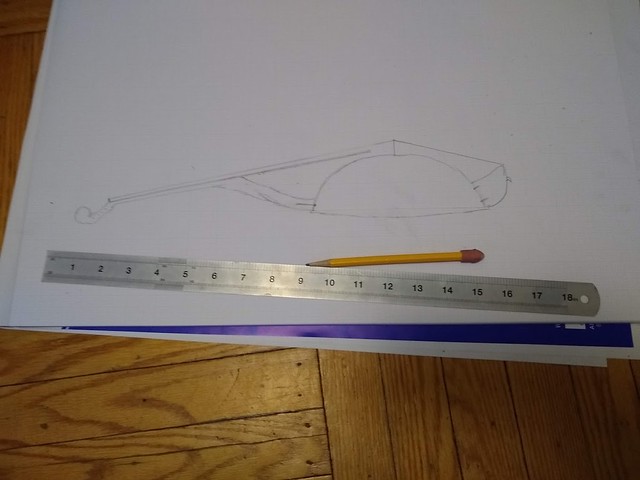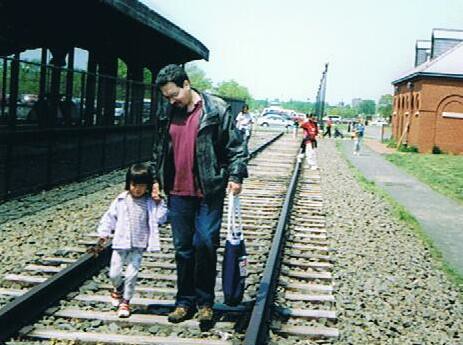|
|
Saturday, January 25th, 2020
Last night it occurred to me (still waiting on delivery of the pan that will be the body of the brass viol) -- I've been thinking of this instrument all along as having a dowel through the body, similar to the other instruments I've built. But if the pan is rigid and strong, it might make more sense to have a separate neck and tail, attached to the pan with bolts. I think this would offer a few key advantages:
- The resonating chamber would be hollow, like a violin's. It seems intuitively like this would produce a clearer tone.
- The joinery would be more straightforward. It will be easier to line up and drill holes in the pan, than to lay out and cut mortises for the dowel.
- The shape of the tail would no longer be limited to an extension of the dowel. I could give the tail height, so the tailpiece would attach closer to the height of the bridge feet. Then the string angle would not be so sharp on the tail side.
(Update: nm, this was a silly idea. The instrument pictured would sound horrible if indeed it would tension up at all.)

posted morning of January 25th, 2020: 3 responses
➳ More posts about viola d'ottone
|  |
Monday, January 20th, 2020
Getting the correct string angle across the bridge is going to be really critical to laying out this instrument. The angle to the tailpiece looks like it will be pretty sharp, from my drawings. I will probably need to lower the bridge aomewhat -- indeed I may go back to the idea of using a viola bridge instead of da gamba. But I really need to see the pan to know, for now I am just guessing. Waiting impatiently on delivery.
The strings should cross the bridge at 153°. Possibly a few degrees sharper, the metal pan as I'm picturing it could stand a fairly strong tension. So that's around 77° on each side from the axis that's the bridge. I think I can make the bridge tilt back some by moving it back on the face of the pan, that will even up the angles.
posted evening of January 20th, 2020: 2 responses
|  |
|
Starting out... will add specs as I calculate them. For reference, Alan Goldblatt's cello specs.
viola d'ottone/ viola.1/ the tenor brass viola
| scale length | 535 | mm | (using ¼ size cello strings) |
| fingerboard length | 490 | mm | (on treble side -- cut away 25mm toward bass) |
| fingerboard width (nut) | 28 | mm |
| fingerboard width (end) | 60 | mm |
| fingerboard height at edge | 6 | mm |
| fingerboard radius | 70 | mm |
| dowel height | 3/4 | in |
| neck angle from vertical | 83 | ° |
| shoulder location | 110
60 | mm
mm | back from heel
above heel |
| neck length under fingerboard | 250 | mm |
neck blank 8/4
(maybe could use 6/4) | 28
7 | in
in | long
wide |
posted evening of January 20th, 2020: Respond
|  |
Wednesday, January first, 2020
The instrument will consist of a round metal dome (either steel or more likely, brass) as a soundboard, a neck and dowel cut from one piece of wood (most likely, cherry)*, steel strings, and a maple bridge, most likely one made for a treble viola da gamba. The significance of the dome shape is, that the bridge can sit on or close to the center of the soundboard, for maximum resonance, without the edges of the pan interfering with the bow stroke.
The scale length will be about 20". Four strings, with tuning of a tenor violin -- G2, D3, A3, E4. I will use strings from a fractional cello for the lower 3 and a full-size cello E string for the top string. (E string for fractional cello doesn't seem to be manufactured anywhere, and the luthier I contacted to ask about it recommended using the full-size string.)
I have a steel wok. I believe the metal is too thick for it to resonate well. I also think it would be possible but quite difficult to grind the metal at the center of the disk thinner using an angle grinder. No guarantee this would increase the resonance but my hunch is it would. I have also ordered a brass wok, which has not arrived yet; I'm thinking it will be the thing to use -- accordingly I'm referring to the instrument as a "brass viol". The arch shape of the brass pan seems like it will be better for sound and for attaching a lining. If there is any question of grinding the pan's thickness down brass must be a lot easier to grind away than steel. Also brass wins for the pretty factor.
I'm planning to build the rest of the instrument besides the back and rough-string it to see what it sounds like prior to carving the back.
Slowly assembling the materials I'll need for this.

- soundboard: brass pan
- ✓ wood for neck
- fingerboard, nut
- ✓ wood for brace
- tailpiece
- pegs
- ✓ bridge
- strings
- ✓ wood for back
- ✓ purfling for back
- soundpost
* Also I think I will need a brace at the bottom of the pan, which I'll make from basswood or willow.
↻...done
posted afternoon of January first, 2020: 2 responses
|  |
Blocky capital letters
of flame
in retro fonts imagined:
fluid flaming fonts, canvas of blacky void
so melt away their meanings
so what's left amounts
to glyphic shapes, just shapes and sounds
and chunky, palpable
consonantal feel.
posted morning of January first, 2020: Respond
➳ More posts about Poetry
|  |
Friday, December 27th, 2019
I've been practicing for the open mic on Monday at Hat City Kitchen, where I'll be playing cello and singing. I was pretty satisfied with my plan to play "Tombstone Blues", "The Raven Rag", and "Jagged Nickel", but then I thought why not make it all originals. I decided I can sing "Rainy Day Woman", so I'm going to open with that. Sylvia is planning to come along, and assuming she does, I will ask her to film the set. I've invited several people -- this is just about the first time I've done that for an open mic. Real Tom said he will come, and John from Traficantes also said he may. Jerry will try to make it.
The songs are all in G*. Oh well, I haven't got a huge range vocally. Also it is easy key (G minor*) to improvise in on the cello.
I made a couple of changes in "The Raven", the bird is now going to have "he" pronoun instead of "she" and is "a jet-black bird" rather than "pretty". If I can make it work, the last two verses will be a good deal slower than the rest of the song and with extra measure on the first and third line. (Similar to Richard Fariña's version in "The Falcon".)
I am hoping there will be a bass player there who wants to back me up and can work out/follow my changes, they are quite simple but I don't have a chord sheet to give.
 *...Wait no, duh, D minor! Not G -- I've been rehearsing these songs in G but I can sing them much better in D. Glad I realized this today (Sunday) & not tomorrow.
posted afternoon of December 27th, 2019: 1 response
➳ More posts about Songwriting
|  |
Saturday, December 21st, 2019
the "the raven" rag for tin-can cello:
posted evening of December 21st, 2019: Respond
➳ More posts about Edgar Allen Poe
|  |
Thursday, December 19th, 2019
 Yesterday I ordered a wok. I'm starting my next metal soundboard instrument, a da gamba tenor violin with carbon steel soundboard1. A rough sketch of the design: Yesterday I ordered a wok. I'm starting my next metal soundboard instrument, a da gamba tenor violin with carbon steel soundboard1. A rough sketch of the design:

parts:
- wok (14" diameter)
- neck + dowel (I'm thinking I will use cherry)
- dowel stop (a small piece of wood that will ride on the bottom of the dowel, as a spacer for the tailpiece)
- back -- arched maple. Thinking I will use some very pretty wormy maple that I've had in my shop for years and years. It is flatsawn but I think it would resonate. Back will be attached with a kerfed lining which I'll need to make. Soundholes will be on the sides of the back.
- tailpiece -- likely will use a 1/4 size cello tailpiece. May need a cork spacer to raise the angle of the tailpiece.
- bridge -- maybe a viola da gamba bridge? or a fractional cello bridge? or a viola bridge?
- strings (steel) -- the tones I am thinking of are G2, D3, A3, E4 (and possibly B4). Maybe use 1/4 cello strings? The scale length will be something like 20". Or another possibility, tune in fourths E2, A2, D3, G3, B3.
- fingerboard
- pegs
posted morning of December 19th, 2019: 1 response
➳ More posts about Luthery
|  |
Sunday, December 15th, 2019
I decay; idk
wtfruok?
posted evening of December 15th, 2019: Respond
➳ More posts about Writing Projects
|  |
|
Happy holidays all! A new take on an old carol.
The "angels we have heard on high" rag for tin-can cello:
the "silent night/joy to the world" rag for #tincancello:
the "god rest ye merry" rag for strings + tin-can cello:
the "herald angels" rag for strings + tin-can cello:
 The "angels we have heard on high" rag for strings:
↻...done
posted morning of December 15th, 2019: 3 responses
➳ More posts about The Tin-can Cello
| Previous posts about Projects
Archives  | |
|
Drop me a line! or, sign my Guestbook.
•
Check out Ellen's writing at Patch.com.
| |

